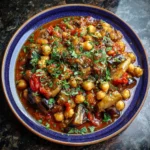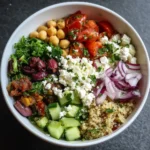Greek Chicken Souvlaki with Tzatziki: A Taste of the Mediterranean
There’s something undeniably magical about Greek Chicken Souvlaki wrapped in warm pita and drizzled with cool, creamy tzatziki. This beloved dish captures the essence of Mediterranean cuisine—fresh ingredients, vibrant flavors, and a harmony of herbs and spices that dance on your palate. Whether you’re enjoying it on a bustling street corner in Athens or recreating it at home, souvlaki offers a delicious journey into Greek culinary tradition. Paired with its signature yogurt-cucumber sauce, this meal is not only satisfying but also wholesome, making it a favorite for weeknight dinners, summer barbecues, or even meal prep.
The History of Greek Chicken Souvlaki
Souvlaki has roots that stretch deep into ancient Greece. The word “souvlati” comes from the Medieval Greek word “souvla,” meaning skewer—a tool used since antiquity to roast small pieces of meat over open flames. Archaeological evidence suggests that people in the Minoan civilization (circa 2000 BCE) were already grilling meat on spits, indicating that souvlaki is one of the oldest forms of fast food in human history. Traditionally made with pork, lamb, or beef, chicken souvlaki gained popularity in the 20th century as a leaner, more accessible alternative.
Over time, souvlaki evolved beyond the simple grilled skewers to include pitas, vegetables, and the now-iconic tzatziki sauce. Street vendors across Greece began serving it as a portable, flavorful meal, often accompanied by fries tucked inside the wrap. Today, Greek Chicken Souvlaki with Tzatziki is celebrated worldwide, embraced not just for its taste but also for its cultural significance and versatility.
Ingredients Breakdown
The beauty of Greek Chicken Souvlaki lies in its simplicity and balance of high-quality, fresh ingredients. Each component plays a crucial role in creating a harmonious flavor profile:
- Chicken: Boneless, skinless chicken thighs or breasts are ideal. Thighs offer more moisture and tenderness due to their higher fat content, while breasts provide a leaner option.
- Olive Oil: Extra virgin olive oil adds richness and helps carry the flavors of the marinade into the chicken.
- Lemon Juice: Freshly squeezed lemon juice brings acidity that tenderizes the meat and brightens the overall taste.
- Garlic: Minced garlic infuses the chicken with a pungent, aromatic depth essential to Mediterranean cooking.
- Dried Oregano: A hallmark herb in Greek cuisine, oregano contributes earthy, slightly peppery notes.
- Paprika: Adds mild sweetness and a touch of color without overwhelming heat.
- Salt & Black Pepper: Fundamental seasonings that enhance all other flavors.
- Pita Bread: Traditional pocket pita or flatbread serves as the vessel, ideally warmed before serving.
- Tzatziki Sauce: Made from Greek yogurt, cucumber, garlic, dill, lemon juice, and olive oil—cooling and tangy, it perfectly balances the grilled chicken.
- Fresh Vegetables: Sliced tomatoes, red onions, cucumbers, and lettuce add crunch and freshness.
- Optional Add-ons: Crumbled feta cheese, Kalamata olives, or roasted red peppers elevate the experience.
Step-by-Step Recipe
Yields: 4 servings
Prep Time: 20 minutes (+ 2–24 hours marinating)
Cook Time: 10–15 minutes
For the Chicken Souvlaki:
- In a large bowl, whisk together 1/3 cup extra virgin olive oil, juice of 1 large lemon, 4 minced garlic cloves, 1 tablespoon dried oregano, 1 teaspoon paprika, 1 teaspoon salt, and 1/2 teaspoon freshly ground black pepper.
- Add 1.5 pounds (680g) of cubed boneless chicken (cut into 1-inch pieces) to the marinade. Toss well to ensure every piece is coated.
- Cover and refrigerate for at least 2 hours, preferably overnight. Marinating longer enhances flavor and tenderness.
- If using wooden skewers, soak them in water for 30 minutes prior to grilling to prevent burning.
- Preheat your grill, grill pan, or broiler to medium-high heat (around 400°F / 200°C).
- Thread the marinated chicken pieces onto skewers, leaving a small space between each cube for even cooking.
- Grill the skewers for 3–4 minutes per side, turning occasionally, until the chicken is golden brown, slightly charred, and cooked through (internal temperature reaches 165°F / 74°C).
- Remove from heat and let rest for 5 minutes before removing from skewers or serving.
For the Tzatziki Sauce:
- Peel half a cucumber (or leave skin on if organic), then grate it using a box grater.
- Place the grated cucumber in a clean kitchen towel and squeeze out as much liquid as possible—this prevents a watery sauce.
- In a medium bowl, combine 1 cup full-fat Greek yogurt, the drained cucumber, 1 minced garlic clove, 1 tablespoon chopped fresh dill, 1 tablespoon extra virgin olive oil, 1 tablespoon lemon juice, 1/2 teaspoon salt, and a pinch of black pepper.
- Mix well, cover, and refrigerate for at least 30 minutes to allow flavors to meld. For best results, make it a few hours ahead.
To Assemble the Wraps:
- Warm the pita bread briefly on the grill, in a toaster oven, or in a dry skillet until soft and pliable.
- Spread a generous spoonful of tzatziki inside each pita.
- Add grilled chicken pieces (remove from skewers).
- Layer in sliced tomatoes, red onion, cucumber, and optional greens like romaine or spinach.
- Top with crumbled feta cheese, a few Kalamata olives, or a sprinkle of fresh dill if desired.
- Fold or roll the pita carefully and serve immediately with extra tzatziki on the side.
Expert Tips for Perfect Souvlaki
- Marinate Overnight: Extended marination ensures maximum flavor penetration and juiciness.
- Don’t Overcook Chicken: Use a meat thermometer to avoid dryness. Remove chicken at 160°F (71°C)—it will carry over to 165°F during resting.
- Use Full-Fat Yogurt: It gives tzatziki a rich, creamy texture that low-fat versions can’t match.
- Squeeze Cucumber Well: Excess moisture is the enemy of thick, luscious tzatziki.
- Char the Pita: Lightly grill the pita for added smokiness and structural integrity when wrapping.
- Double the Tzatziki: It keeps well for up to 5 days and is excellent as a dip, salad dressing, or sandwich spread.
- Skewer Alternatives: If you don’t have skewers, use heavy-duty foil packets or cook the chicken in a grill basket.
Variations and Customizations
This recipe is highly adaptable to suit different tastes, dietary needs, or available ingredients:
- Vegetarian Option: Replace chicken with grilled halloumi cheese, portobello mushrooms, zucchini, bell peppers, and eggplant for a hearty vegetarian souvlaki.
- Vegan Version: Use marinated tofu or tempeh instead of chicken, and substitute dairy-free yogurt in the tzatziki.
- Gluten-Free: Serve the souvlaki over a Greek salad or in gluten-free flatbread or lettuce wraps.
- Spicy Kick: Add 1/2 teaspoon crushed red pepper flakes or a dash of cayenne to the marinade or tzatziki.
- Herb Variations: Swap dill for mint in the tzatziki for a fresher, cooler flavor.
- Meat Alternatives: Try pork, lamb, or shrimp souvlaki using the same marinade with adjusted cooking times.
- Bowl Style: Skip the pita and serve over rice, quinoa, or a bed of greens for a nourishing grain bowl.
- Kids’ Version: Mild down the garlic and skip onions; serve chicken with extra tzatziki for dipping.
Health Considerations and Nutritional Value
Greek Chicken Souvlaki with Tzatziki is a nutritionally balanced meal that aligns well with heart-healthy and Mediterranean diet principles. Here’s why:
- Lean Protein: Chicken provides high-quality protein essential for muscle repair and satiety.
- Healthy Fats: Olive oil and Greek yogurt contribute monounsaturated fats and probiotics, supporting gut health and reducing inflammation.
- Low in Carbohydrates: When served without pita or with whole-grain alternatives, it fits low-carb or keto-friendly diets.
- Rich in Vitamins & Minerals: Garlic, lemon, cucumber, and fresh herbs deliver antioxidants, vitamin C, potassium, and anti-inflammatory compounds.
- Probiotics: Fermented Greek yogurt contains beneficial bacteria that support digestive health.
Nutrition Estimate per Serving (1 wrap with chicken, tzatziki, vegetables, and whole wheat pita):
- Calories: ~450–550 kcal
- Protein: 35–40g
- Fat: 20–25g (mostly unsaturated)
- Carbohydrates: 35–45g
- Fiber: 5–7g
- Sodium: ~700–900mg (can be reduced by lowering added salt)
Note: Sodium levels can be managed by using low-sodium yogurt, limiting added salt, and choosing unsalted feta. For lower-calorie versions, reduce oil slightly and increase vegetable volume.
Full Ingredient List
For the Chicken Souvlaki:
- 1.5 lbs (680g) boneless, skinless chicken thighs or breasts, cubed
- 1/3 cup extra virgin olive oil
- Juice of 1 large lemon (~3 tablespoons)
- 4 cloves garlic, minced
- 1 tablespoon dried oregano
- 1 teaspoon paprika
- 1 teaspoon salt
- 1/2 teaspoon freshly ground black pepper
- 8–10 wooden or metal skewers
For the Tzatziki Sauce:
- 1 medium cucumber, peeled and grated
- 1 cup full-fat Greek yogurt
- 1 clove garlic, minced
- 1 tablespoon fresh dill, finely chopped (or 1 tsp dried)
- 1 tablespoon extra virgin olive oil
- 1 tablespoon fresh lemon juice
- 1/2 teaspoon salt
- Pinch of black pepper
For Assembly:
- 4–6 pita breads (whole wheat or traditional)
- 1 large tomato, sliced or diced
- 1/2 red onion, thinly sliced
- 1/2 cucumber, sliced
- Fresh lettuce or spinach (optional)
- Crumbled feta cheese (optional)
- Kalamata olives (optional)
- Fresh dill or parsley for garnish
Detailed Directions
Follow the step-by-step recipe above for complete instructions. To summarize the key stages:
- Prepare the marinade and coat chicken thoroughly; marinate for 2+ hours.
- Soak wooden skewers and preheat grill or stovetop grill pan.
- Thread chicken onto skewers and grill until fully cooked and slightly charred.
- Make tzatziki by combining strained cucumber, yogurt, garlic, herbs, and seasonings; chill before serving.
- Warm pitas and assemble wraps with chicken, tzatziki, fresh veggies, and optional toppings.
- Serve immediately with lemon wedges and extra sauce on the side.
Frequently Asked Questions (FAQ)
Can I bake the chicken instead of grilling?
Yes! Preheat oven to 400°F (200°C). Place marinated chicken on a lined baking sheet and bake for 18–22 minutes, flipping halfway, until cooked through.
How long does tzatziki last in the fridge?
Up to 5 days in an airtight container. Stir before serving as separation may occur.
Can I make souvlaki ahead of time?
Absolutely. Marinate the chicken up to 24 hours in advance. Cooked chicken stays fresh in the fridge for 3–4 days and reheats well in a skillet or microwave.
Is souvlaki gluten-free?
The marinade and tzatziki are naturally gluten-free, but check pita labels or use gluten-free flatbread to keep the entire dish GF.
Can I freeze Greek chicken souvlaki?
Yes, though texture may change slightly. Freeze cooked chicken in marinade or plain for up to 3 months. Thaw in fridge and reheat gently. Tzatziki does not freeze well due to yogurt separation.
What can I serve with souvlaki besides pita?
Try it with Greek salad, lemon rice, roasted potatoes, hummus platter, or grilled vegetables.
Why is my tzatziki watery?
Likely due to insufficient draining of the cucumber. Always squeeze grated cucumber in a towel to remove excess moisture before mixing.
Can I use store-bought tzatziki?
Yes, but homemade is superior in flavor and healthier (no preservatives or added sugars). Look for brands with minimal ingredients if buying pre-made.
Summary
Greek Chicken Souvlaki with Tzatziki is a flavorful, healthy, and versatile meal that brings the sun-drenched tastes of the Mediterranean to your table. With tender marinated chicken, creamy homemade tzatziki, and fresh vegetables wrapped in warm pita, it’s a satisfying dish perfect for any occasion.










